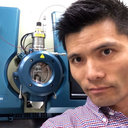Combined metabolic and transcriptional profiling identifies pentose phosphate pathway activation by HSP27 phosphorylation during cerebral ischemia.
Sleutelwoorden
Abstract
The metabolic pathophysiology underlying ischemic stroke remains poorly understood. To gain insight into these mechanisms, we performed a comparative metabolic and transcriptional analysis of the effects of cerebral ischemia on the metabolism of the cerebral cortex using middle cerebral artery occlusion (MCAO) rat model. Metabolic profiling by gas-chromatography/mass-spectrometry analysis showed clear separation between the ischemia and control group. The decreases of fructose 6-phosphate and ribulose 5-phosphate suggested enhancement of the pentose phosphate pathway (PPP) during cerebral ischemia (120-min MCAO) without reperfusion. Transcriptional profiling by microarray hybridization indicated that the Toll-like receptor and mitogen-activated protein kinase (MAPK) signaling pathways were upregulated during cerebral ischemia without reperfusion. In relation to the PPP, upregulation of heat shock protein 27 (HSP27) was observed in the MAPK signaling pathway and was confirmed through real-time polymerase chain reaction. Immunoblotting showed a slight increase in HSP27 protein expression and a marked increase in HSP27 phosphorylation at serine 85 after 60-min and 120-min MCAO without reperfusion. Corresponding upregulation of glucose 6-phosphate dehydrogenase (G6PD) activity and an increase in the NADPH/NAD+ ratio were also observed after 120-min MCAO. Furthermore, intracerebroventricular injection of ataxia telangiectasia mutated (ATM) kinase inhibitor (KU-55933) significantly reduced HSP27 phosphorylation and G6PD upregulation after MCAO, but that of protein kinase D inhibitor (CID755673) did not affect HSP27 phosphorylation. Consequently, G6PD activation via ischemia-induced HSP27 phosphorylation by ATM kinase may be part of an endogenous antioxidant defense neuroprotection mechanism during the earliest stages of ischemia. These findings have important therapeutic implications for the treatment of stroke.



